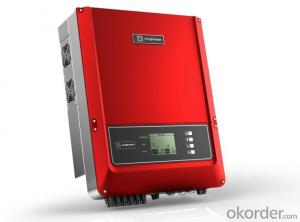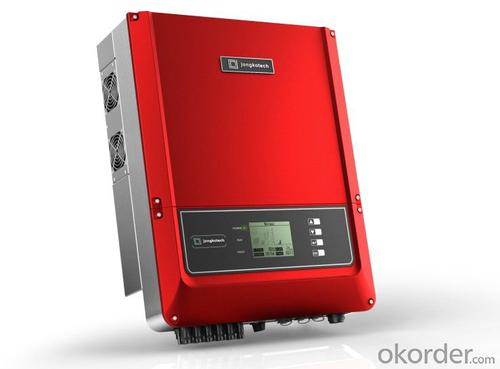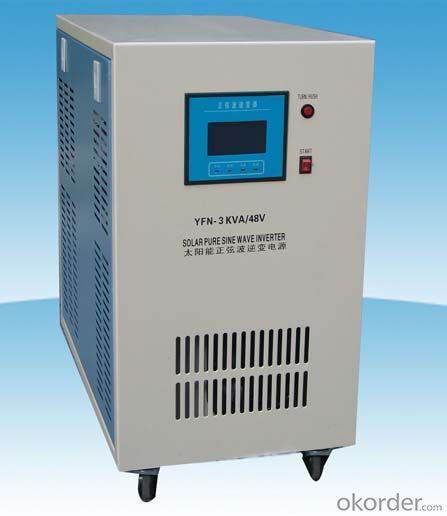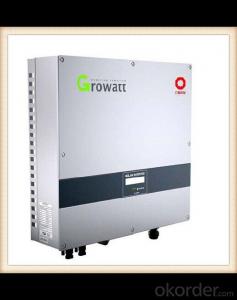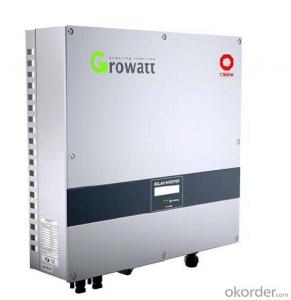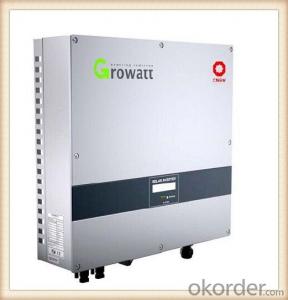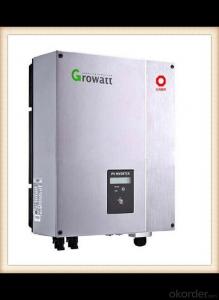3.6kW Hybrid Solar Inverter CNBM-H Hybrid Inverter
- Loading Port:
- Shanghai
- Payment Terms:
- TT OR LC
- Min Order Qty:
- 1000 watt
- Supply Capability:
- 100000000 watt/month
OKorder Service Pledge
OKorder Financial Service
You Might Also Like
1.Description of the Solar Inverter
2KW hybrid inverter
Pure sine wave output
Microprocessor controlled to guarantee stable charging system
Multiple operations: Grid tie , Off grid , and grid tie with backup
Built-in MPPT solar charger
LCD display panel for comprehensive information
Multiple communication
Green substitution for generators
User adhustable charging current up to 25A
2.Data sheet of the Solar Inverter
| Model | CNBM-H 2KW |
| Rated Power | 3000W |
| Grid-tie operation | |
| PV Input(DC) | |
| Maximum DC power | 3200W |
| Nominal DC voltage / Maximum DC voltage | 360 VDC/500 VDC |
| Start voltage /Initial Feeding Voltage | 116 VDC/150 VDC |
| MPP voltage range | 250 VDC ~ 450 VDC |
| Number of MPP Trackers/ Max input current | 1/1 X13A |
| GRID OUTPUT (AC) | |
| Nominal Output Voltage | 208/220/230/240 VAC |
| Output Voltage Range | 184 - 264.5 VAC |
| Nominal Output Current | 13.1A |
| Power Factor | >0.99 |
| EFFICIENCY | |
| Maximum Conversion Efficiency (DC/AC) | 96% |
| European Efficiency@ Vnominal | 95% |
| OFF-GRID OPERATION | |
| AC INPUT | |
| AC Startup Voltage /Auto Restart Voltage | 120 - 140 VAC / 85 VAC |
| Acceptable Input Voltage Range | 170 - 180 VAC |
| Maximum AC Input Current | 25A |
| PV INPUT (DC) | |
| Maximum DC Voltage | 500 VAC |
| MPP Voltage Range | 250 VAC~450 VAC |
| Maximum Input Current | 1/1 X13A |
| BATTERY MODE OUTPUT (AC) | |
| Nominal Output Voltage | 208/220/230/240 VAC |
| Output Frequency | 50HZ/60HZ(auto sensing) |
| Output Waveform | Pure sine wave |
| Efficiency (DC to AC) | 93% |
| HYBRID OPERATION | |
| PV INPUT (DC) | |
| Nominal DC voltage / Maximum DC voltage | 360 VDC/ 500 VDC |
| Start voltage /Initial Feeding Voltage | 116 VDC /150VDC |
| MPP voltage range | 250VDC ~450VDC |
| Maximum Input Current | 1/1 X13A |
| GRID OUTPUT (AC) | |
| Nominal Output Voltage | 208/220/230/240 VAC |
| Output Voltage Range | 184 ~264.5 VAC |
| Nominal Output Current | 13.1A |
| AC INPUT | |
| AC Startup Voltage /Auto Restart Voltage | 120 - 140 VAC /85 VAC |
| Acceptable Input Voltage Range | 170~ 180 VAC |
| Maximum AC Input Current | 25A |
| BATTERY MODE OUTPUT (AC) | |
| Nominal Output Voltage | 208/220/230/240 VAC |
| Efficiency (DC to AC) | 93% |
| BATTERY & CHARGER | |
| Nominal DC Voltage | 48VDC |
| Maximum Charging Current | 25A |
| GENERAL | |
| PHYSICAL | |
Dimension, D X W X H (mm) | 420x415x170 |
| Net Weight (kgs) | 15.5 |
| INTRRF ACE | |
| Communication Port | RS-232/USB |
| Intelligent Slot | Optional SNMP ,Modbus, and AS400 cards available |
| COMPLIANCE | |
| Standard | CE, VDE, 0216-1-1, VDE-AR-N 4105 |
3.Applications of the Solar Inverter
Inverter not only has direct communication transform function, but also has the maximum limit to carry on the function of the solar cell function and system fault maintenance function. In the aggregate, have active operation and shutdown function, maximum power tracking control function, prevent operation function alone (grid system use), the active voltage adjustment functions (grid system use), dc testing functions (grid system use), dc grounding detection function (grid system use)
4.IMages of the Solar Inverter

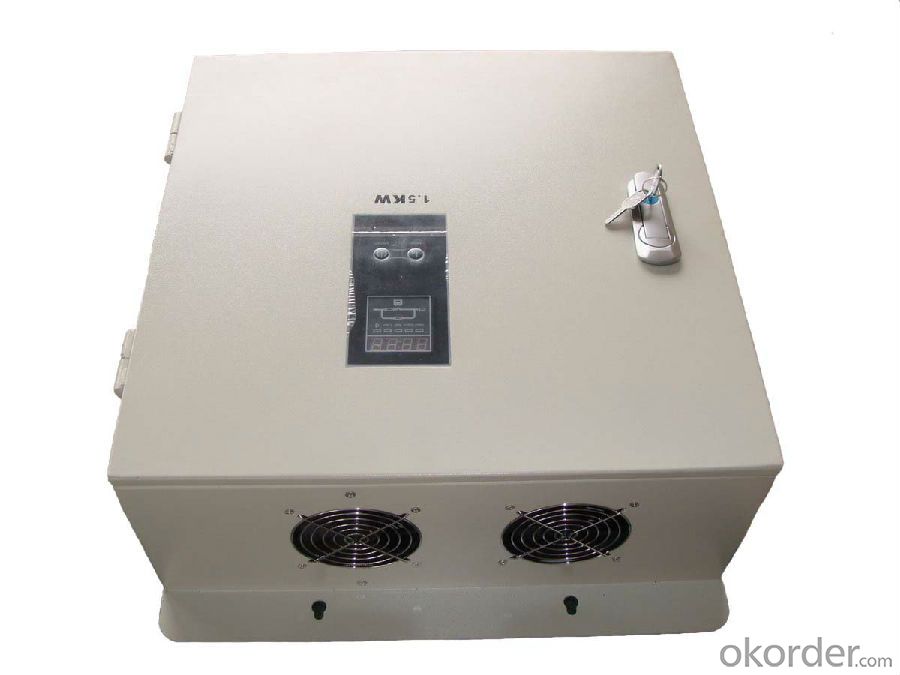
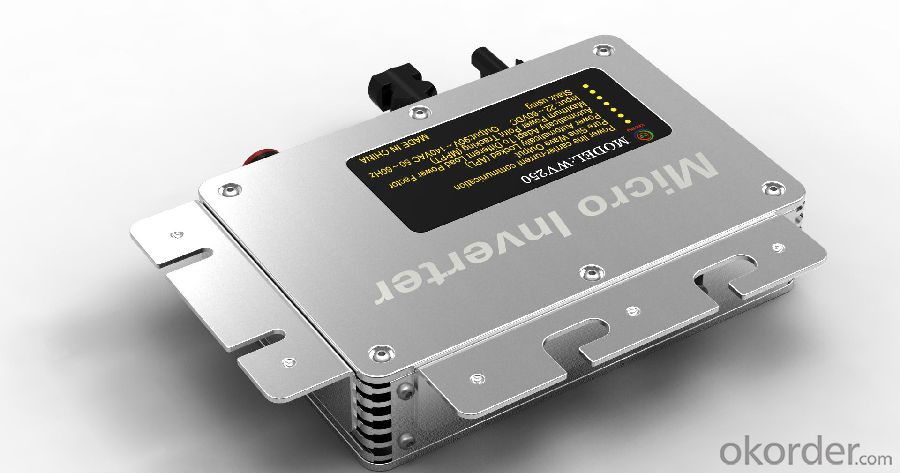
FAQ
Q: Do you have the CE, TUV, UL Certification?
A: We’ve already passed all the tests, and any certificate is available.
Q: Have you ever sold your products to companies in my country?
A: Of course, we have customers in all general PV markets, but I think we should expand our market share along with the market growth.
Q: When did your company set up? You are a new company, how can I believe your quality?
A: We entered into Solar PV industry in 2005, now we have several plants in manufacturing of a-Si and c-Si panels, and our capacity is 220MW per year. Till now we have already passed all the tests by authorized laboratories, e.g. TUV, CE, UL.
Q: Can you help us install the module if we cooperate with you?
A: We haven’t entered into installation sector, but we have the plan in near future.
Q: How do you pack your products?
A: We have rich experience on how to pack the panels to make sure the safety on shipment when it arrives at the destination.
Q: Can you do OEM for us?
A: Yes, we can.
Q: Can we visit your factory?
A: Surely, I will arrange the trip basing on your business schedule.
- Q: What is the role of a surge protector in a solar inverter?
- The role of a surge protector in a solar inverter is to safeguard the inverter and connected electrical equipment from voltage spikes and power surges that can occur due to lightning strikes, grid fluctuations, or other electrical disturbances. It helps to prevent damage to the inverter and ensures the stability and longevity of the solar power system.
- Q: Can a solar inverter be installed outdoors?
- Yes, a solar inverter can be installed outdoors. However, it is important to ensure that the inverter is designed to be weatherproof and can withstand the elements. Additionally, proper ventilation and protection from direct sunlight should be considered when installing the inverter outdoors.
- Q: Can a solar inverter be used in a solar-powered desalination system?
- Yes, a solar inverter can be used in a solar-powered desalination system. A solar inverter is responsible for converting the direct current (DC) electricity generated by solar panels into alternating current (AC) electricity, which is required for the operation of the desalination system. By utilizing a solar inverter, the system can effectively harness solar energy and convert it into usable power for the desalination process.
- Q: What is the maximum power rating of a solar inverter?
- The maximum power rating of a solar inverter typically depends on the specific model and manufacturer. It can range from a few hundred watts for small residential inverters to several megawatts for large-scale commercial or utility-grade inverters.
- Q: Can a solar inverter be used without solar panels?
- No, a solar inverter cannot be used without solar panels. Solar panels are the primary source of energy for a solar inverter, which converts the direct current (DC) generated by the panels into alternating current (AC) that can be used to power electrical devices. Without solar panels, there is no source of renewable energy for the inverter to convert, rendering it useless.
- Q: Can a solar inverter be used in a mobile or portable solar system?
- Yes, a solar inverter can be used in a mobile or portable solar system. Portable solar systems typically consist of solar panels, a battery, and an inverter. The solar panels generate electricity from the sun, which is stored in the battery. The inverter then converts the stored DC power from the battery into AC power that can be used to power various devices and appliances. This allows for the utilization of solar energy even in remote or mobile settings.
- Q: What are the safety features of a solar inverter?
- The safety features of a solar inverter typically include protection against overvoltage, overcurrent, and short-circuit conditions. They also often have built-in ground fault protection and insulation monitoring to detect any faults in the system. Additionally, many solar inverters have anti-islanding features to prevent them from operating during a power outage, ensuring the safety of utility workers.
- Q: What are the potential risks of overcharging a battery connected to a solar inverter?
- Overcharging a battery connected to a solar inverter can lead to several potential risks. Firstly, it can cause excessive heat buildup in the battery, which can lead to reduced battery life and even damage the internal components. Secondly, overcharging can cause electrolyte leakage or gas buildup within the battery, increasing the risk of explosion or fire hazard. Additionally, overcharging can result in the release of toxic gases, such as hydrogen, which can be harmful if not properly ventilated. Finally, overcharging can also have an adverse effect on the overall efficiency of the solar system, as excess energy is wasted during the charging process.
- Q: What are the key factors affecting the lifespan of a solar inverter?
- The key factors affecting the lifespan of a solar inverter include the quality of components used in its manufacturing, the design and construction of the inverter, the operating conditions and environment it is subjected to, and the maintenance and care it receives throughout its lifespan.
- Q: What are the key factors affecting the compatibility of a solar inverter with other system components?
- The key factors affecting the compatibility of a solar inverter with other system components include the voltage and frequency requirements, the type of PV modules used, the communication protocols supported, the maximum power output capacity, the efficiency and reliability of the inverter, and the overall system design and configuration.
Send your message to us
3.6kW Hybrid Solar Inverter CNBM-H Hybrid Inverter
- Loading Port:
- Shanghai
- Payment Terms:
- TT OR LC
- Min Order Qty:
- 1000 watt
- Supply Capability:
- 100000000 watt/month
OKorder Service Pledge
OKorder Financial Service
Similar products
Hot products
Hot Searches
Related keywords
